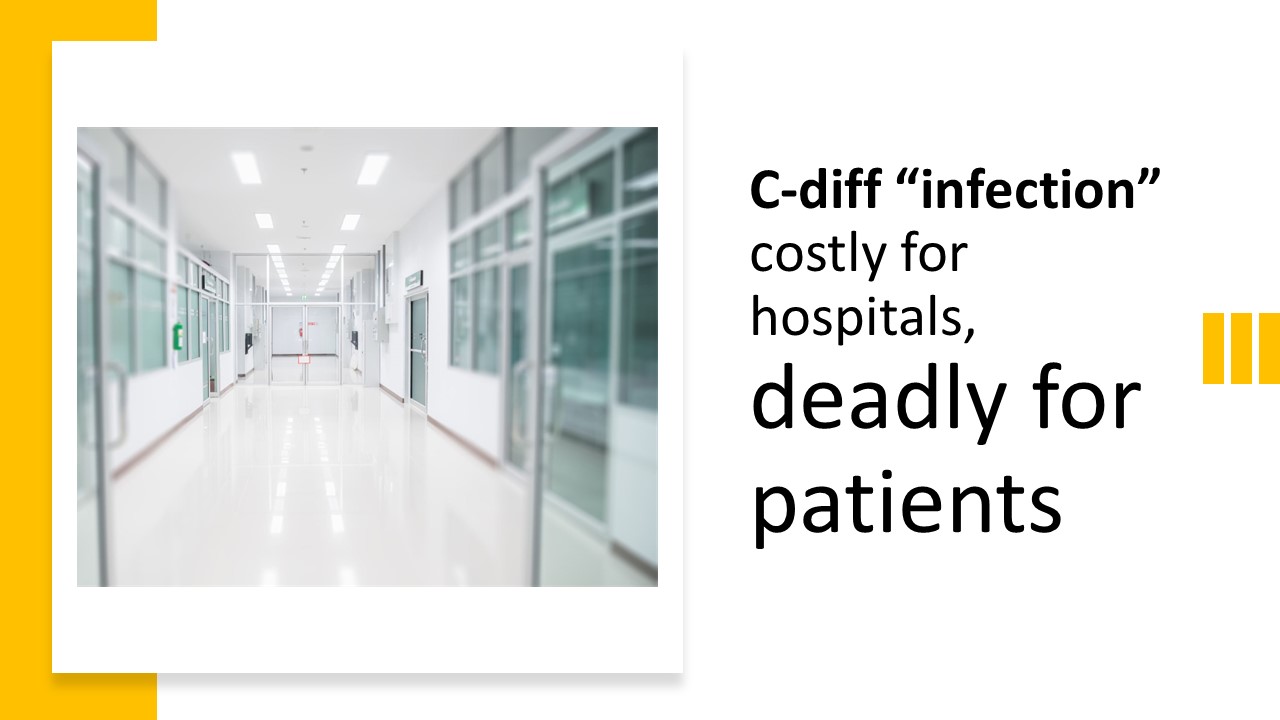C-diff infections. They conjure up fear, as they should, but as you will come to learn in my video presentation, the term “infection” is a misnomer here. What we’re really talking about is an extreme case of dysbiosis. That’s right. And I have plenty of proof to back up this statement. Now this presentation isn’t applicable to too many viewers. The average person doesn’t even think about C-diff in their daily lives. And although they are exposed to the spores on an almost daily basis, they shouldn’t worry if they are healthy. There are only two small groups of people for whom this presentation has an enormous amount of relevance. Those who have already had a C-diff infection, and hospitals who want to cut down on C-diff infections (more specifically recurrence) within the walls of their hospital.
CDI is the leading cause of antibiotic- and healthcare-associated infective diarrhea in the United States. It affects approximately 500,000 patients annually in the United States, of these around 30,000 will die. The Centers for Disease Control (CDC) identified CDI as an “urgent threat”, highlighting the need for immediate and aggressive action to prevent complications and recurrences of this infection Between 20 and 35% of initial CDI patients will experience a recurrence (usually within 30 days). Of the patients who have a recurrence, up to 60% will experience subsequent recurrences. Hospital readmission with CDI as a primary diagnosis incurs a revenue loss of almost $5000 and the potential loss is nearly threefold higher for patients who are re-hospitalized with rCDI as a secondary diagnosis.
C-diff spores are everywhere. At the playground, on your shoes, on your pets and in your food. You can’t avoid them. And, if C-diff were a true infection, then you’d think the people most susceptible would be hospital workers, as that’s where the dreaded hospital acquired C-diff occurs. C-diff spores have been found in hospital samples from beds, toilets, door handles and doctor’s uniforms. But hospital staff members aren’t suffering and dying from C-diff infections. Why is that?
In my presentation I take a deep dive into the risk factors. I highlight the individual bacteria at play in this extreme case of dysbiosis (an unhealthy balance of the bacteria and bugs in your gut). I explain how antibiotics and PPIs alter the microbiome, enabling C-diff pathogenicity.
In the end, it comes down to the balance of good verses bad bacteria in the gut, it’s just that simple. And one end result of this dysbiosis is enabling the germination of the C-diff spore by primary bile acids, particularly taurocholate. You see, your microbiome does a great many things, one of which is maintaining a healthy balance of primary to secondary bile acids. When out of balance, this is C-diff’s opportunity to cause problems.
I also cover the amazing benefits of FMT (fecal microbiota transfer/transplant). This is literally the act of replacing the microbiome of a sick person, with that of a healthy one. But even here, we have a couple of key considerations. First, the donor must be chosen for the task. The rCDI patient has specific microbial needs, which I’ve identified. Second, in general, the benefits of FMT only last for so long (this number varies wildly). So, it’s key to feed the new microbiome with the fuels that the keystone health-promotors need, to enjoy the benefits as long as possible.
For the patient, if you’ve had one or more CDIs in the past, you should act to rectify what is clearly a dysbiotic microbiome. Short of FMT, my protocol is the next best thing. It’s important to drive a significant shift in the microbiome with properly blended and dosed prebiotics, designed to feed the health-promotors who are severely depleted in the CDI microbiome. As for hospitals, it’s critical to support the microbiome to avoid rCDIs. Again, the philosophy is the same as with the patients. The only variable is whether or not an FMT is involved.
As the former director of medical education for a microbiome firm, I recognized the good that can be done in regards to morbidity, mortality and the costs of C-diff infections. Although my proposal wasn’t pursued, now with my own platform, I offer my expertise in the field of the microbiome. If you’re in the hospital setting, and this presentation resonates with you, reach out by email at my website (The Microbiome Expert). If you’re a patient who has previously had one or more C-diff infections, visit the protocols tab on my website (Protocols – The Microbiome Expert), where you will find a protocol best suited to your microbial needs.
The references cited within this video presentation
The burden of CDI in the United States: a multifactorial challenge – PubMed (nih.gov)
Pathogenicity and virulence of Clostridioides difficile – PubMed (nih.gov)
Burden of Clostridium difficile infection in the United States – PubMed (nih.gov)
Asymptomatic Clostridium difficile colonisation and onward transmission – PubMed (nih.gov)

